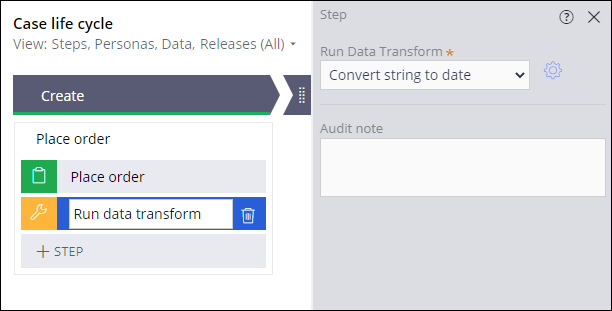
Manipulate application data
As a Pega Business Architect (BA) who collaborates with business and IT stakeholders, it is helpful to understand application data, where it comes from, how the system uses the data, and how the system manipulates the data across the application. For example, a Case receives an Order delivery date value from an external system of record. The value comes over as text, such as "December 4, 2021". The Pega application requires conversion of the text to a Date-only Field Type, such as 12/04/2021, to process the data correctly.
In App Studio, the manipulation of application data occurs through a Data Transform. Data can also be manipulated using an Activity, but that can only be done in Dev Studio and the use of Activities is not encouraged.
In this topic, you explore Data Transforms, how they work, and why Data Transforms are preferred to Activities.
Data Transforms
The purpose of a Data Transform is to manipulate data in an application. Data Transforms copy or drive data into the fields that you require. You can use Data Transforms to convert data from one type to another, move data between objects, calculate values, change formats, and set default values.
In the following image, click the + icons to explore how Pega Platform™ uses Data Transforms to improve the checkout process of a purchasing application:
Data Transform configuration in App Studio
In addition to using Data Transforms to copy data, you can use Data Transforms to convert data from one type to another type. For example, you receive an order delivery date input from another system as a string value, such as "December 4, 2021." Use a Data Transform to copy and convert the stored string format of the delivery date into the date value property, 12/04/2021.
In App Studio, you can apply Data Transforms by using the Run Data Transform Automation or a pre/post-processing Action.
Note: For more information about Data Transform configuration in App Studio, see Creating a Data Transform in App Studio.
Run Data Transform Automation
The Run Data Transform Automation runs the selected Data Transform at runtime, or you can define a new Data Transform. For example, you configure the Run Data Transform Automation to run the Convert string to date Data Transform, as shown in the following figure:
Pre/post-processing
You can configure a Step to run a Data Transform before the Step runs, which is a pre-processing Action, or after the Step runs, which is a post-processing Action. In the purchasing application example, you can configure the Shipping information Step with a post-processing Action that runs a Data Transform to copy the shipping information to the Billing Address View. The following figure displays the Shipping Information Step with a post-processing Data Transform:
Note: For more information about pre- and post-processing, see Pre- and post-processing in Flow Actions.
Activities versus Data Transforms
In Pega Platform, Activities automate processing beyond simple source-to-target data manipulation.
Activity Rules use a sequence of steps to automate the system to support complex processes, elaborate calculations, or when a Rule requires an Activity in order to run.
Activities might be appropriate for the following processes:
- Background processing
- Complex loops
- Parallel processing
- Recurring scheduled events
- Services
Activities often require Java code to accomplish their task and, therefore, are complex to build, maintain, and update.
Compared to Activities, Data Transforms are less resource-intensive and process information more quickly. As a result, you can use Data Transforms in place of Activities to accomplish many common data manipulation tasks, including:
- Normalizing data for use with a Data Page.
- Copying data from one page to make a new page.
- Mapping properties and their values from an existing page to a new page.
- Defining one or more initial fields on a page and setting their Values. A Data Transform can set many field values on a page in one processing Step.
As a Pega BA, encourage the IT team to use Data Transforms whenever possible to accomplish data manipulation tasks.
Confirm your knowledge with the following interaction:
This Topic is available in the following Module:
If you are having problems with your training, please review the Pega Academy Support FAQs.
Want to help us improve this content?

